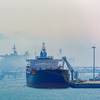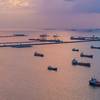Faster Than A Speeding...
The technology to cost efficiently discover and recover oil and gas in increasingly deeper part of the Gulf of Mexico has quickly led to the development of bigger, stronger and more ruggedly equipped Offshore Service Vessels, not only on drawings boards but operating on the waterways. The discovery of oil and gas fields such as Auger, Marlim and Mars, have among others, highlighted the vast potential for drilling success and the inadequacy of the current fleet of OSVs to perform the job as cost effectively as possible.
The oil companies have invested billions in efforts to discover the 'next big find,' and now that many of the complexities have been largely solved, namely the ability to accurately project volume of product at such great depths — orders for new, more capable vessels in ever increasing numbers.
One of the more notable vessels delivered in the last six months is BJ Blue Ray, a vessel built by Leevac Shipyards LLC, and delivered to Hornbeck. The vessel had been chartered to BJ Services, Houston, Texas, and finished as a well stimulation vessel. Measuring 265 x 60 ft. (80.7 x 18.2 m) with a 22-ft. (6.7-m) hull depth, the vessel’s mass and design allow it to work in higher seas, while providing impressive tankage below deck. A common feature of the Hornbeck vessels is Dynamic Positioned (DP) navigation systems. Dynamic positioning was first developed to help keep drill ships precisely over the well they were drilling regardless of wind and sea state. All of the recently built Hornbeck vessels have DP-2 capability that calls for independent bow and stern thrusters each driven by a separate power source. Vessel positioning variables such as wind, and sea state are fed into a central computer that feeds information to the main engines and the thrusters to keep the vessel on station and can do so even if there is a single point failure on one of the thrusters or main engines.
The Rolls-Royce Design Solution
Rolls-Royce has won contracts worth $76 million to supply design and equipment packages for nine offshore service vessels, which will be built in four different shipyards for owners in Brazil, France, Norway and the U.S.
The ship designs and packages of Rolls-Royce equipment will be supplied in 2002 and 2003, and the shipyards, located in Brazil, Denmark and Norway are scheduled to deliver the vessels in 2003 and 2004.
Five of the latest orders are for the popular UT 755 supply vessel. The Aker Promar yard in Brazil will build two; one for Edison Chouest Offshore and one for Tidewater, while Orskov Christensen's Staalskibsvaerft in Denmark will construct a UT755L for the French company, SURF. This Danish yard has also won a contract to build a UT722-T offshore-going tug for Unie Redding-en Sleepdienst in Belgium. The 20,000 hp Rolls-Royce design vessel has a design bollard pull of about 210 tons and will be the most powerful vessel the yard has built to date. Delivery is scheduled for January 2003.
Three examples of the UT722 design are also on order at Fels-Setal in Brazil for Delba Maritima S.A., which is a company jointly owned by Bourbon Maritime in France and Commercial Perfuradora Delba Daiana Ltda in Brazil. Two of these vessels will be 248 ft. (75.6 m) type UT722 and the third, a UT722L measuring 6.5 ft. (2 m) longer. All will have complete Rolls-Royce integrated ship system packages, including design, main engines, propellers, rudders, transverse thrusters, retractable azimuth thrusters and main winches.
Jane Tide Makes An Impact
Tidewater Inc. has taken delivery of the 260-ft. (79.2-m) M/V Miss Jane Tide. The Miss Jane Tide, which is Tidewater's first VS 480 platform supply vessel, was built by the company's own Quality Shipyards, L.L.C. in Houma, La. The ship, designed by the Norwegian firm Vik-Sandvik, is the first of four identical vessels to be built by Quality. The Miss Jane Tide is a 260-ft. PSV and is the first domestically constructed vessel to be delivered under Tidewater's new construction program announced in January 2000. In addition, Tidewater has also taken operational delivery of the M/V Ace Nature, one of eight vessels acquired from The Sanko Steamship Co., Ltd. in late 2000. At 276 ft. (84.1-m), the Ace Nature, a UT 745 PSV, is one of the largest ships among Tidewater's fleet.
Upon entering into Tidewater's available fleet, both the Miss Jane Tide and the Ace Nature went on charter with large international oil companies at rates of $20,000 per day.
Halliburton Brings Viking To GOM
Halliburton Subsea, a business unit of Halliburton's Energy Services Group, is deploying its ultra modern multi-purpose support vessel, MSV Subsea Viking, to the Gulf of Mexico on a long-term basis. The vessel, which arrived in U.S. waters in early February 2002, will be available for a wide variety of field development and maintenance tasks including, flexible flowline and umbilical lay, manifold and template installation, remotely operating vehicle (ROV) and survey work and other subsea intervention operations. This 340-ft. (103.6-m) vessel is particularly suitable for supporting deepwater operations. Key features include a 100-ton heave compensated crane, a 1,200-ton capacity below deck carousel, twin 10,000-ft. rated Work Class ROV systems and 12,400-sq. ft. of available working deck area. With more than 10,000-kW of diesel electric power available and an International Maritime Organization/Norwegian Maritime Directorate (IMO/NMD) Class 3 Dynamic Positioning system, the vessel will be capable of operating safely in close proximity to structures and with a very wide weather capability.










